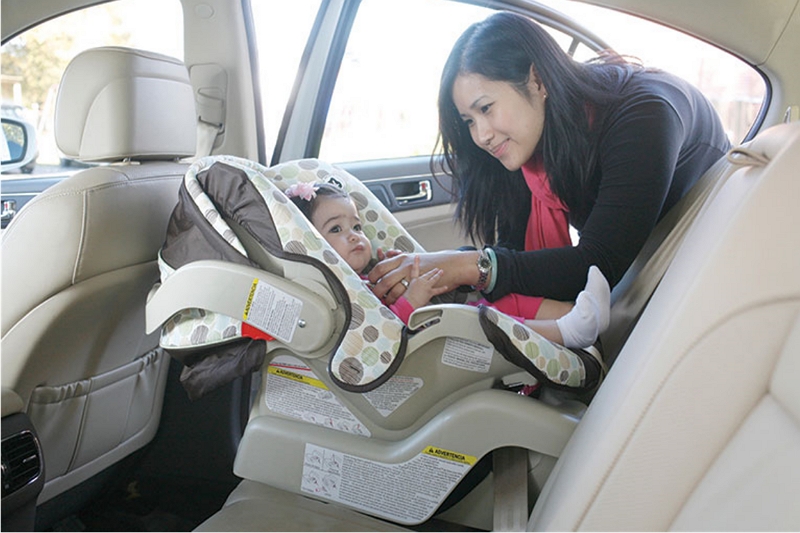Where to check car seat installation? When you have a car seat, it is important to make sure you are installing the child restraint properly. Where do you check?
Sometimes parents get in a hurry when putting their children into their seats and therefore don’t install them securely enough. The National Highway Traffic Safety Administration has these simple tips for how to know if your baby or toddler’s safety seat is installed correctly:

- The harness straps should be at or below your child’s shoulders; they shouldn’t be above his shoulder level where he might begin to slip out of them. If the buckles don’t adjust low enough (or if they’re behind him), try reclining the backrest more than usual or raising its top by using an insert.
- The harness retainer clip should be at your child’s armpit level and the straps shouldn’t twist or tangle as you buckle them in. If they do, try rethreading them–they may not have been clipped together properly before being buckled into the slot (this sometimes happens when a car seat is installed too far back). Make sure no excess webbing hangs out of any slots it goes through; if so, you’ll need to thread it again from another direction.
- Make sure your baby’s legs don’t dangle over the edge of his safety seat and that he can sit comfortably without slouching forward against its sides: this will ensure his spine stays straight and protected throughout an accident.
- The safety seat’s handle should be in the correct locked position. Make sure the chest buckle is fastened securely, too. If it’s not low enough or if your baby can wiggle under it easily, try reclining the backrest more than usual to make up for his new height until you’re able to adjust its crotch strap properly (if he gets out of that one as well, this means you’ll need a smaller model).
- Finally, check that nothing feels loose on either side of your child’s head and neck–his shoulders shouldn’t feel squeezed by any part of the harness system underneath him; they should rest comfortably against whatever surface they touch above him—the shoulder belt needs to work with them rather than against them.
You can also use a mirror to see what’s going on behind you when your child is in the car seat; this will help make sure his limbs and neck are properly supported but not compressed or uncomfortable (if they look like they’re bending at weird angles, try reclining the backrest more than usual).
If your baby seems unhappy while strapped in—he cries continuously without stopping for even short periods of time–you probably need to re-adjust everything.
How much should a baby weigh to face forward in 2021?
There are multiple ways to measure a baby’s weight. The easiest way is using their birth weight, which can be determined by how much they weigh at birth or when they leave the hospital. However, an infant should continue gaining weight after the first month of life until reaching approximately five pounds in total body weight.
If your child was born prematurely there might have been some complications with them catching up on growth milestones so you may want to set up a visit with our paediatricians for further information regarding this specific case and what steps you need to take next. We would love to help guide you through this process!
When can babies face forward in 2021?
Babies can face forward when they are six months old and weigh more than 20 pounds.
What do you do with old car seats?
Well, there are many options. You can donate them to local charities or even sell them on Craigslist so another family might use your seat for one more child.
We wanted our old seats out of the house and in a new life with someone else who would give it love while using this safety device that has saved us from injury too many times to count!
And you know what? It feels great! I highly encourage everyone to get rid of their car seats at least every six years (or when they expire/are recalled). The whole experience was amazing; we got about $75 back per seat which paid pretty much all of my husband’s graduation gift!
How long should a baby be in a rear-facing car seat?
Each car seat has a different height and weight limits when it comes to rear-facing. The American Academy of Pediatrics recommends that children stay in the rear-facing position until they are two years old or reach the maximum height/weight limit for their specific carseat.
For example, if your child is 30 pounds (which is typically around 18 months) then you should be using a convertible car seat like this one which can hold up to 35 pounds – still with them facing backwards!
What is the safest convertible car seat on the market?
The Clek Foonf is the safest convertible car seat on the market. It earns a perfect safety rating from NHTSA, with an additional side impact protection feature that makes it unique to other models.
In addition, you can also use Latch with this model as well as convert its system into a belt-positioning booster when your child outgrows their rear-facing position.
The price may be high but if you choose the top pick in convertible seats, then why not go for one that has been tested and tried?
You would never want to take chances by going for cheaper options only to end up with dangerous products which could put your kid at risk of injuries or death because they do not meet industry standards.
This particular model has also been tested and approved in Europe, which is another sign that it has met international safety standards.
